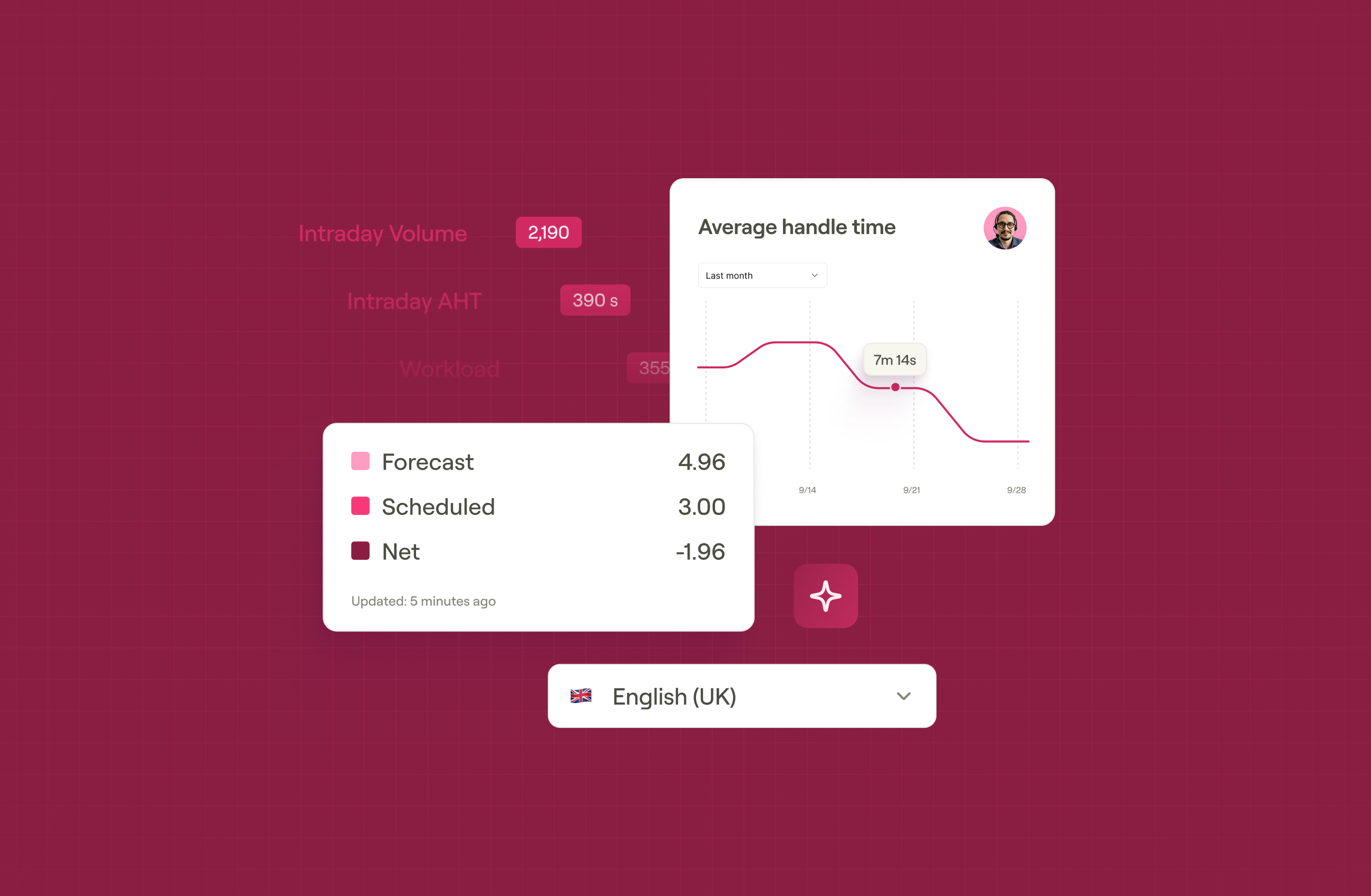Making data-driven decisions is more important now than ever in a dynamic and competitive business landscape. AI-powered solutions like sentiment analysis algorithms serve as a business advantage for many organizations.
Understanding employee emotions and attitudes is critical for business success. Analyzing employee sentiment can provide this essential insight. Sentiment analysis can empower businesses with powerful insights that extend beyond traditional contact center analytics. These often fail to fully capture employee perspectives.
In this blog, we’ll explore how employee sentiment analysis works and why it’s necessary in modern workforce management processes.
What is sentiment analysis?
Sentiment analysis is a natural language processing (NLP) function that identifies and extracts emotional tone from data. It quantifies subjective information, determining general opinions or feelings from an audience. You can use this information to classify sentiments as positive, neutral, or negative. Scoring categories can also become more granular and customizable to a business’s needs.
Sentiment analysis is often used for quantifying customer service experiences and feelings surrounding an interaction. However, in workforce engagement management, managers can also apply this to employees.
What is employee sentiment?
Many organizations use sentiment analysis algorithms for customer feedback. Understanding employee sentiment is just as important. Some would argue even more important!
Analyzing employee sentiment allows organizations to understand the emotional tone behind employee communications, performance, and interactions. It's not just about understanding what your employee feel, it's about understanding the why too. This data gives business leaders the insights needed to make employee-centric decisions.
Approaches to sentiment analysis tools
There are several approaches to building sentiment analysis tools. Most approaches utilize natural language processing (NLP) and machine learning (ML) algorithms. The primary sentiment analysis approaches include rule-based sentiment analysis and machine learning sentiment analysis. Some solutions involve a hybrid of both.
Rule-based
Rule-based sentiment analysis uses text classification and feature extraction to analyze text and assign positive or negative sentiment values to specific words. These words are attributed to positive or negative sentiments. A sentiment score is assessed based on the volume of these categories.
Machine learning (ML)
A machine learning-based approach teaches a system to identify sentiment through repeatedly analyzing large datasets. This method uses techniques like deep learning and neural networks to train a computer to recognize human sentiment with high accuracy and adapt as human behavior changes.
Types of sentiment analysis
Based on specific business needs, organizations can choose from various sentiment analysis solutions. Typically, multiple approaches are combined to create an effective system that addresses complex business challenges.
Fine-grained
As its name suggests, fine-grained sentiment analysis focuses on the polarity of an opinion. Rather than a sentiment simply being positive, negative, or neutral, fine-grained sentiment analysis measures the degree of polarity in data. Think of surveys that ask whether you highly agree, somewhat agree, neither agree nor disagree, somewhat disagree, or highly disagree. A fine-grained sentiment analysis uses this type of spectrum when analyzing data.
Aspect-based sentiment analysis (ABSA)
Aspect-based sentiment analysis helps identify customer or employee sentiments regarding specific elements of a product, service, or experience. ABSA can detect sentiments associated with different aspects of what's being measured, making it optimal for analyzing large sets of detailed data that may cover numerous aspects or features.
Intent-based
Intent-based sentiment analysis goes beyond polarity and aims to understand the underlying motivations and feelings behind an identified emotion. This approach can fill critical gaps for businesses seeking insights into customer intent and employee satisfaction.
Emotional detection
Emotional detection also offers additional insights into human feelings, attributing select text and phrases to identifiable human emotions like happiness or frustration.
The importance of sentiment analysis in workforce engagement management
So, why does this matter in workforce management and workforce engagement management?
Sentiment analysis can provide insights that are critical to understanding both your customers and your employees. With this data, organizations can make informed decisions to improve customer satisfaction and employee experiences.
Sentiment analysis in workforce management software can provide the following benefits to an organization.
Enhanced employee engagement measurement
Traditional surveys and employee satisfaction metrics don’t always paint a complete picture of engagement. Additional analysis can provide:
- Real-time insights into employee satisfaction
- Feedback that might not emerge in structured surveys
- Continuous monitoring rather than point-in-time assessments
Early detection of workplace issues
Continuous analysis of employee performance patterns and feedback can give businesses insights to detect workplace issues early. This includes:
- Identifying emerging concerns before they escalate
- Detecting signs of employee burnout, dissatisfaction, or conflict
- Enabling proactive intervention strategies
Improved decision making
Data-driven insights can provide organizations with valuable information to improve HR processes, including helping:
- Inform policy decisions based on employee feedback
- Allocate resources to address specific workplace challenges
- Evaluate the impact of organizational changes
Reduce employee turnover and improve retention
Sentiment analysis can help organizations understand employee needs to improve their experience, team dynamics, and collaboration opportunities. This can reduce turnover by:
- Predicting attrition risks through sentiment indicators
- Identifying factors driving employee satisfaction or dissatisfaction
- Enabling personalized retention strategies
Ways to measure employee sentiment
You can measure employee sentiment through both qualitative and quantitative methods. Sentiment sources can include:
- Employee surveys
- Engagement and performance metrics
- Focus groups
- 1:1 check-ins with managers
- Exit interveiws
Sentiment analysis tools can make analyzing large data sets more accessible, painting a more holistic picture of your workforce. These solutions make it easier to detect patterns and find early solutions to engagement concerns.
Implementing sentiment solutions in workforce management
Solutions should be implemented both to align with your specific business needs and to uphold transparency with employees. Here are key considerations when implementing sentiment solutions into your workforce management processes:
- Thoroughly assess your sources. This could be internal communications, employee feedback forms, performance reviews, or other external platforms.
- Transparently collect data. Be sure to communicate openly with your teams about the collection of data to improve their experience.
- Prioritize privacy protections. Ensure data collection practices are ethical and in compliance with necessary regulations.
- Balance interpretations. Sentiment tools should be supplemental to understanding the employee experience, ensure managers are still having meaningful conversations and face time with employees.
Predictive intelligence in workforce management
As modern business challenges evolve, workforce management must change too—with the need for predictive, proactive, data-driven technology being greater now than ever.
Employees generate vast amounts of data that, when properly analyzed, can guide organizations toward improved scheduling, performance management, and talent development. Rather than relying on outdated workforce engagement management methods, organizations must move toward more intelligent workforce practices.
Learn more about how Aspect is building for the future of work with workforce intelligence.









